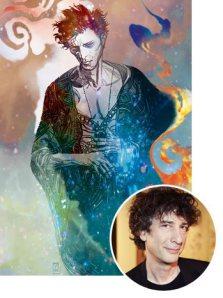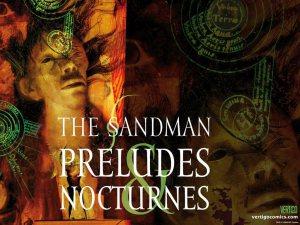According to Deadline, WB/DC is officially moving forward with a film adaptation of beloved fantasy author Neil Gaiman’s classic comic book The Sandman. Gaiman is aboard as producer as is David S. Goyer, who is thought to have composed a basic outline for the film’s plot which will be elaborated upon by an as-yet un-hired screenwriter. Joseph Gordon-Levitt is joining the pair as producer. There is the possibility he might also direct and star in the film, although Gordon reminded his Twitter followers that the only thing for sure right now is that he will help produce the movie:
Just to clarify, folks. I've signed on as a producer on Sandman. The rest remains to be seen. Delighted you guys are excited. I am too!—
Joseph Gordon-Levitt (@hitRECordJoe) December 17, 2013
Of course, a David S. Goyer/Neil Gaiman/Joseph Gordon-Levitt-led adaptation of Sandman has been rumored since last month. This finally moves it past the rumor stage. But…a Sandman movie? Yeah, we’ll believe it when we see it. We come by our skepticism in this area honestly.
Who or What is The Sandman?
There have been multiple characters to bear the name The Sandman in the pages of DC comics, the first one appearing in 1939 as a superhero who wore a gas mask and used a special sleeping gas gun to sedate his enemies. A new version was created in 1974 as a being which had the appearance of a superhero but was in fact the true mythical Sandman, primarily pre-occupied in this iteration with safeguarding the dreams and nightmares of one specific child. This version was relatively short-lived, revived with an entirely new background in Wonder Woman in 1983. He again remained a minor presence. Cut to a few years later and author Neil Gaiman had a proposal for how best to revive the 1974 version. DC thought Gaiman might actually be better off starting from scratch, though. So, they let him just create something almost entirely new, while maintaining the title The Sandman.

At times, it’s almost too obvious that Dream basically looks exactly like its author, Neil Gaiman
In Gaiman’s version, the Sandman is actually the anthropomorphic representation of dream. His actual name is Dream or Morpheus or….we’ll stop there because the dude has like 10 aliases, Dream and Morpheus being the most commonly used of the bunch. He is the Lord of the dream world who was held captive for over 70 years by an occult ritual. Upon his escape, he seeks vengeance upon his captors, but returns to his realm only to find that his kingdom has fallen in disrepair in his absence. He has to either change with the times or die, and chooses the former. The intricately plotted, inescapably convoluted, but impossibly brilliant series features various elements of mythology, horror, historical events and absurdist humor. Beyond Dream, there are supporting characters like Dream’s gothic punk rocker looking sister Death, his talking animal assistants, and an immortal The Corinthian who has two mouths for eyes.
The original series ran for 75 issues from 1989 to 1996, with a prequel series launched just this year. Along with the work of Alan Moore (The Swamp Thing, The Watchmen, V for Vendetta), Frank Miller (The Dark Knight Returns, Batman: Year One), The Sandman was part of the comic book renaissance of the 1980s/1990s when influential titles came out which challenged the popular conception of what could be achieved and addressed in the comic book format. For its part, The Sandman won just about every award it could, becoming one of the few graphic novels to ever end up on The New York Times Bestseller List. It was one of the contributing factors to DC’s 1993 decision to create a separate imprint called Vertigo through which they would release their more mature, critically-acclaimed titles meant for adult audiences. Sandman was one of DC’s best sellers, with over half of its readership being female. It remains for many their first ever comic book purchase. The only reason it stopped is because Gaiman always intended for it to be a limited series, wisely securing a clause in his contract preventing DC from continuing the series upon his departure.
What Other Attempts Have Their Been to Adapt the Character to Film or TV?
1996 Movie
Rogery Avary was hired to direct a film adaptation even though at the time he had only directed one feature film, Killing Zoe (1993). He was most known for having assisted Quentin Tarantino with the writing of True Romance, Reservoir Dogs, and Pulp Fiction, although Avary never received anything more than a “story by” credit. This was still enough to net him a Best Original Screenplay Oscar alongside Tarantino for Pulp Fiction. Hot off of this success, Warner Bros. entrusted him to bring Morpheus to the screen, although he was forced to collaborate with two screenwriters who had already completely a first draft of a script, Ted Elliott and Terry Rossio. These writing partners would much later find success writing the screenplay for the first Pirates of the Caribbean movie, but at the time their credits only included the Fred Savage kids movie Little Monsters (1989), being among the 18 credited writers of Disney’s Aladdin (1992), and a little-seen Robert Heinlen novel adaptation The Puppet Masters (1994).

Their plan was to merge the Sandman storylines “Preludes and Nocturnes” with “A Doll’s House.”
This team proved themselves not up to the task, Avary eventually fired over differing views on the creative direction. To be fair, he specifically disagreed with executive producer Jon Peters, and that it is a recurring theme throughout the career of Peters, the producer behind the 1989 Batman.
Later Drafts
Without a director and the pair of screenwriters let loose, Warner Bros. kept plugging away, bringing in new writers to take a crack at additional drafts of the script. The most notorious of these subsequent drafts came from William Farmer, who to this point only has three credits as a screenwriter – Bullethead (2002), the story for Jonah Hex (2010), and the still-in-development Star and the Snowman (2015). Gaiman has indicated despising Farmer and any other subsequent film scripts. However, as a professional courtesy Gaiman kept his criticism short and sweet, calling one of the Sandman screenplays the worst script he’d ever read. Ain’t It Cool News had the freedom to be far more specific in their criticism of the Farmer script:
“At the end, everything that happens in the book is just wiped away with that old familiar movie cop-out, ‘It was all just a dream.’ Ugh. Gaiman never, never cheated us like that. Even if something happened in a dream, it mattered. It counted. That’s the whole point. Our dream lives and our waking lives are one and the same. One affects the other. Gaiman made the point over and over, and Farmer has ignored it utterly. The script is devoid of imagination. Farmer has created a ‘Nightmare plague’ that’s loosely based on a section of PRELUDES & NOCTURNES (the exceptional and unforgettable ’24 Hours’), and it’s nothing but a bunch of pointless atrocities without moral heft or payoff. He misses everything that makes the original work so unique, so special, so brilliant..”
And that appeared to be the end of that. The film isn’t going anywhere; why not TV?
2010 TV Series with Eric Kripke

Eric Kripke’s main claim to fame at the time was Supernatural, a universe in which the supernatural creates we hear stories about are real, and there are a collection of people secretly hunting them down to keep us safe
Warner Bros.’ first attempt to adapt Sandman to TV was with eventual The Wolverine director James Mangold, who consulted with Gaiman and pitched an idea for an adaptation to HBO. However, that went nowhere. The next man up was Eric Kripke in 2010, who at the time had just left Supernatural and had yet to move on to his current show, Revolution. He worked with Gaiman on ways to adapt the story to TV, but in 2011 Kripke told an audience at PaleyFest, “Unfortunately, for a lot of varying reasons, Sandman is not in the works, at least for this season… [It] just didn’t quite happen this season through nobody’s fault, and hopefully we can do it again in the future.”
That leads us to the present. Earlier this year, DC Entertainment President Diane Nielsen indicated Sandman was one of five characters she most wished to adapt to screen, indicating to The Hollywood Reporter she believed it could be as rich a cinematic universe as Harry Potter. If Gordon-Levitt does officially become the director, it would be in keeping with recent trends whereby big budget films keep down costs by hiring largely unproven directors who won’t command a large salary (e.g., Marc Webb-Amazing Spider-Man, Gareth Edwards-Godzilla, Colin Trevorrow-Jurassic World). Levitt’s only directing credit to date is this year’s Don Jon, which we regarded as being an admirably flawed debut that announced Levitt as a director of great ambition whose future work behind the camera should be just as highly anticipated as his work in front of it. He was Warner Bros. de facto heir apparent as Batman after The Dark Knight Rises, but they’ve gone a different direction. Since then, he’s been a rumored target to lead several other comic book franchises, e.g., Guardians of the Galaxy and Ant-Man.

Gordon-Levitt in Hesher, vaguely similar to how he might appear as Dream/Morpheus if starring in Sandman
However, Sandman remains one of those tantalizing fantasy properties like Stephen King’s The Dark Tower series which Hollywood continually fails at attempting to adapt. Some things are simply un-filmmable, and when they are we might walk away wishing they’d remained unfilmed, e.g., Zack Snyder’s version of The Watchmen. Comic book properties remain hot items for adaptation, but it is really only superhero comics which consistently do well. Outside of that, it’s been a real mixed bag both creatively and financially – Scott Pilgrim Vs. The World, Jonah Hex, Red, R.I.P.D., 2 Guns, Oblivion, Dredd, Bullet to the Head, Kick-Ass, The Spirit, V for Vendetta, 300, Sin City, Constantine, etc. The same could also be said for prior Neil Gaiman adaptations, Coraline and Stardust, both brilliant films which likely struggled to turn a profit.
Ain’tItCoolNews proposed that to adapt Sandman you need merely adapt the first two collections, “Preludes and Nocturnes” and “The Doll’s House.” Okay, so what happens in those two:
“The first issue of the series concerns Dream being captured by a human being, a sort of Alastair Crowley wannabe who strips Dream of the three symbols of his office — a ruby, a bag of sand, and his helmet. Each of these items contains some portion of Dream’s essence. When he finally frees himself after 100 years, he goes to reclaim the three items, each of which has fallen into wildly different hands- the helmet ending up in the hands of a Demon in Hell, the bag of a sand with a junkie girl, and the ruby a prize possession of a resident of Arkham Asylum.
Once Dream has reclaimed his icons, he returns to his home The Dreaming only to find it atrophied and dying. Several of his major dream creatures have escaped, leading to another major arc as Dream hunts them down. At the same time, he becomes aware of a girl named Rose Walker who is a physical juncture for The Dreaming. The only way to prevent her from opening a rift in the dream kingdom is to kill her, something Dream does not want to do. One of the most terrifying of Gaiman’s creations is a creature that Dream has to hunt down called The Corinthian. Created as the ultimate nightmare, terror given physical form, The Corinthian is a serial killer with vicious razor-sharp teeth where his eyes should be. Along with several other dreams, he is hunted down and retrieved by Morpheus. There’s no real fights here because there’s no way for these creatures to resist. They don’t just belong to Dream… he made them, and he can simply unmake them if he chooses.”
Honestly, almost everything involving Morpheus tracking down those portions of his essence which have been robbed would be completely and utterly superfluous if adapted to film. You would have to cut all of that out to get straight to the point of establishing Morpheus as the Lord of dreams who has been away from over 70 years but now returns to find his realm destitute. Plus, Morpheus’ lack of actual fights with his creations would seem to play well on the page but translate poorly to the screen. Of course, you can adapt later parts of the story when we start getting to the cool supporting characters. However, can a fantasy adaptation which does not feature at its center a Harry Potter or Bilbo/Frodo Baggins everyman-type work as a mainstream film?
We’ll soon find out just based upon whether or not this latest Sandman adaptation ever gets past the script stage.
What do you think? Is Sandman actually film-able? Or not?

